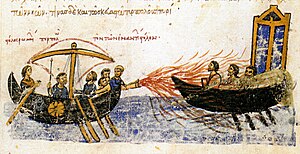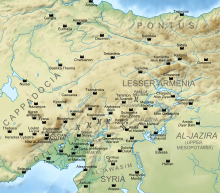The Arab-Byzantine wars were a series of military conflicts between the Arab Caliphate and the Byzantine Empire during the 7th - 12th centuries , launched by the invasion of the troops of the righteous caliphate into Byzantium in the 630s and the continuation of the gains by the Umayyad Caliphate during the first half of the 11th century. As a result of these wars, Byzantium lost a large number of its territories in the east and south: Palestine , Syria , Armenia , Egypt , North Africa , Cyprus , Crete , Sicily , parts of Asia Minor .
| Arab-Byzantine Wars | |||
|---|---|---|---|
| Main conflict: Arab conquests | |||
 Greek fire that was widely used during the Arab-Byzantine Wars. | |||
| date | 629 - 1054 | ||
| A place | Levant (Syria) , Egypt, North Africa , Anatolia , Crete, Sicily, Southern Italy | ||
| Total | The seizure of large areas of Byzantium by the Arabs (Levant, Mesopotamia , North Africa and Sicily) Successful counterattack of the empire in the X — XI centuries and the return of southeastern Anatolia, Armenia, northern Levant, Southern Italy and Crete | ||
| Opponents | |||
| |||
| Commanders | |||
| |||





The emergence of Arabian Arabs in the 630s led to the rapid loss of the southern provinces of Byzantium (Syria and Egypt) and their accession to the Arab caliphate. Over the next 50 years, under the rule of the Umayyads, the Arabs also made repeated attacks in yet Byzantine Asia Minor, threatened to conquer the Byzantine capital, Constantinople, and defeated the Byzantine African Exarchate twice. The situation began to stabilize only after the failure of the second Arab siege of Constantinople , when the Taurus Mountains on the eastern edge of Asia Minor were established as a heavily fortified and largely deserted border. During the rule of the Abbasid dynasty, relations between Byzantium and the Arab Caliphate improved slightly: there was an exchange of embassies and even truce periods, but the conflict remained the norm, with attacks and counterattacks continued almost annually, supported either by the Abbasids or by the local rulers throughout the 10th century .
In the first centuries, Byzantines were usually on the defensive and avoided open battles, preferring to retreat to their fortifications. Only after 740 they began to launch counter-attacks, but the Abbasid Empire could still strike back, often with massive and destructive incursions into Asia Minor. With the decline and fragmentation of the Abbasid Empire after 861, the Byzantine Empire began to strengthen simultaneously under the rule of the Macedonian dynasty , and the counterattack began. Over the next 50 years, from about 920 to 976, the Byzantines finally broke through the defenses of the Arabs and regained their control over Northern Syria and Great Armenia. In the last century, the Arab-Byzantine wars were mainly dominated by border conflicts with the Fatimids in Syria, but the border remained stable until the emergence of the Seljuks after 1060.
After the conquests of the Seljuks, the situation completely changed. Byzantium was driven out of Asia Minor, and the Abbasid Caliphate was considerably weakened. There were no more important conflicts between Arabs and Byzantium.
Prerequisites
The grueling Byzantine-Sasanian wars of the 6th and 7th centuries led to the weakening of both empires in the face of the sudden emergence and expansion of the Arab caliphate. The last of these wars ended in victory for the Byzantines: the emperor Heraclius returned all the lost territories and returned the Life-giving Cross to Jerusalem in 629. However, both empires did not have time to recover, because after a few years they found themselves under the onslaught of Islam-united Arabs, which, according to the characteristics of historian J. Howard-Johnston, "can only be compared with the human tsunami wave."
Muslim conquests in 634–718
Arab troops coped relatively easily with the conquest of continental Syria and Palestine , but the coastal cities, which continued to communicate freely with the metropolis by sea and who had the opportunity to receive food and reinforcements, continued to persevere. One of the largest cities, the center of Palestine First, Caesarea (Qaisariya) , for seven years since the beginning of the Arab invasion of Palestine, has withstood several sieges. Ascalon , Tir (Sur), Sidon (Pollock), Tripoli (Tarabulus), Arados, Antarados (Antartus, now Tartus ) persevered. The circumstances and the time of the conquest of the coastal cities are not clear. Until the mid-1940s, the main theater of operations against Byzantium was the eastern part of Asia Minor, where the advance of the Arabs was halted by the impassable Taurus Ridge . Separate raids through the mountain passages to Cilicia were undertaken as early as the end of the 30s. In 645, the Byzantines launched a widespread counter-offensive. They tried to expel the Arabs from Egypt , on the Syrian coast, probably then Irka was repelled. The Arabs were able to quickly change the course of hostilities in their favor. In Egypt, a significant part of the Byzantine expeditionary army died in battles for Alexandria . Irka was returned, and in Asia Minor Mu'awiya ibn Abu Sufyan in 646 captured several fortresses. The Byzantine counterattacks showed Muawiya that without domination at sea, any point on the Syrian coast would be constantly under threat of attack. In 647, Muaviyah began to prepare a fleet in Akka for an attack on Cyprus . At the end of winter 648, 220 ships with troops went to Cyprus. The first in the history of the Caliphate naval expedition was successful, although a light storm patted the fleet after leaving the harbor. Cyprus did not expect attacks from the sea and could not prevent the landing. Arab detachments scattered around the island, robbing unfortified villages and taking prisoners away. The ruler of the island agreed to pay 7,200 dinars annually (as much as the emperor of Byzantium) and remain neutral. [one]
Stabilization of boundaries, 718–863
Byzantium counteroffensive
Notes
- ↑ Bolshakov O. G. The history of the Caliphate. 2. The era of great conquests (633-656). M .: Eastern literature, 1993.